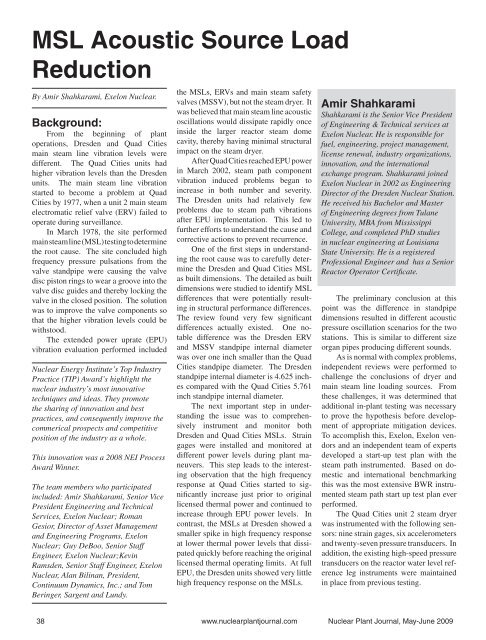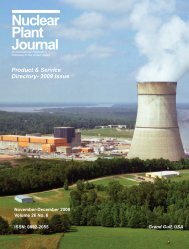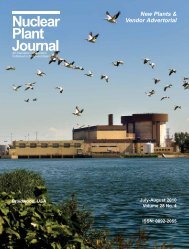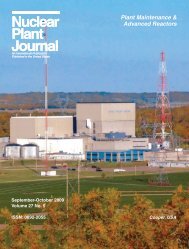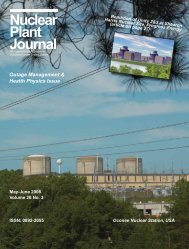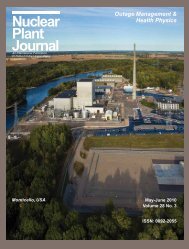Nuclear Plant Journal Outage Management ... - Digital Versions
Nuclear Plant Journal Outage Management ... - Digital Versions
Nuclear Plant Journal Outage Management ... - Digital Versions
You also want an ePaper? Increase the reach of your titles
YUMPU automatically turns print PDFs into web optimized ePapers that Google loves.
MSL Acoustic Source Load<br />
Reduction<br />
By Amir Shahkarami, Exelon <strong>Nuclear</strong>.<br />
Background:<br />
From the beginning of plant<br />
operations, Dresden and Quad Cities<br />
main steam line vibration levels were<br />
different. The Quad Cities units had<br />
higher vibration levels than the Dresden<br />
units. The main steam line vibration<br />
started to become a problem at Quad<br />
Cities by 1977, when a unit 2 main steam<br />
electromatic relief valve (ERV) failed to<br />
operate during surveillance.<br />
In March 1978, the site performed<br />
main steam line (MSL) testing to determine<br />
the root cause. The site concluded high<br />
frequency pressure pulsations from the<br />
valve standpipe were causing the valve<br />
disc piston rings to wear a groove into the<br />
valve disc guides and thereby locking the<br />
valve in the closed position. The solution<br />
was to improve the valve components so<br />
that the higher vibration levels could be<br />
withstood.<br />
The extended power uprate (EPU)<br />
vibration evaluation performed included<br />
<strong>Nuclear</strong> Energy Institute’s Top Industry<br />
Practice (TIP) Award’s highlight the<br />
nuclear industry’s most innovative<br />
techniques and ideas. They promote<br />
the sharing of innovation and best<br />
practices, and consequently improve the<br />
commerical prospects and competitive<br />
position of the industry as a whole.<br />
This innovation was a 2008 NEI Process<br />
Award Winner.<br />
The team members who participated<br />
included: Amir Shahkarami, Senior Vice<br />
President Engineering and Technical<br />
Services, Exelon <strong>Nuclear</strong>; Roman<br />
Gesior, Director of Asset <strong>Management</strong><br />
and Engineering Programs, Exelon<br />
<strong>Nuclear</strong>; Guy DeBoo, Senior Staff<br />
Engineer, Exelon <strong>Nuclear</strong>;Kevin<br />
Ramsden, Senior Staff Engineer, Exelon<br />
<strong>Nuclear</strong>, Alan Bilinan, President,<br />
Continuum Dynamics, Inc.; and Tom<br />
Beringer, Sargent and Lundy.<br />
the MSLs, ERVs and main steam safety<br />
valves (MSSV), but not the steam dryer. It<br />
was believed that main steam line acoustic<br />
oscillations would dissipate rapidly once<br />
inside the larger reactor steam dome<br />
cavity, thereby having minimal structural<br />
impact on the steam dryer.<br />
After Quad Cities reached EPU power<br />
in March 2002, steam path component<br />
vibration induced problems began to<br />
increase in both number and severity.<br />
The Dresden units had relatively few<br />
problems due to steam path vibrations<br />
after EPU implementation. This led to<br />
further efforts to understand the cause and<br />
corrective actions to prevent recurrence.<br />
One of the first steps in understanding<br />
the root cause was to carefully determine<br />
the Dresden and Quad Cities MSL<br />
as built dimensions. The detailed as built<br />
dimensions were studied to identify MSL<br />
differences that were potentially resulting<br />
in structural performance differences.<br />
The review found very few significant<br />
differences actually existed. One notable<br />
difference was the Dresden ERV<br />
and MSSV standpipe internal diameter<br />
was over one inch smaller than the Quad<br />
Cities standpipe diameter. The Dresden<br />
standpipe internal diameter is 4.625 inches<br />
compared with the Quad Cities 5.761<br />
inch standpipe internal diameter.<br />
The next important step in understanding<br />
the issue was to comprehensively<br />
instrument and monitor both<br />
Dresden and Quad Cities MSLs. Strain<br />
gages were installed and monitored at<br />
different power levels during plant maneuvers.<br />
This step leads to the interesting<br />
observation that the high frequency<br />
response at Quad Cities started to significantly<br />
increase just prior to original<br />
licensed thermal power and continued to<br />
increase through EPU power levels. In<br />
contrast, the MSLs at Dresden showed a<br />
smaller spike in high frequency response<br />
at lower thermal power levels that dissipated<br />
quickly before reaching the original<br />
licensed thermal operating limits. At full<br />
EPU, the Dresden units showed very little<br />
high frequency response on the MSLs.<br />
Amir Shahkarami<br />
Shahkarami is the Senior Vice President<br />
of Engineering & Technical services at<br />
Exelon <strong>Nuclear</strong>. He is responsible for<br />
fuel, engineering, project management,<br />
license renewal, industry organizations,<br />
innovation, and the international<br />
exchange program. Shahkarami joined<br />
Exelon <strong>Nuclear</strong> in 2002 as Engineering<br />
Director of the Dresden <strong>Nuclear</strong> Station.<br />
He received his Bachelor and Master<br />
of Engineering degrees from Tulane<br />
University, MBA from Mississippi<br />
College, and completed PhD studies<br />
in nuclear engineering at Louisiana<br />
State University. He is a registered<br />
Professional Engineer and has a Senior<br />
Reactor Operator Certifi cate.<br />
The preliminary conclusion at this<br />
point was the difference in standpipe<br />
dimensions resulted in different acoustic<br />
pressure oscillation scenarios for the two<br />
stations. This is similar to different size<br />
organ pipes producing different sounds.<br />
As is normal with complex problems,<br />
independent reviews were performed to<br />
challenge the conclusions of dryer and<br />
main steam line loading sources. From<br />
these challenges, it was determined that<br />
additional in-plant testing was necessary<br />
to prove the hypothesis before development<br />
of appropriate mitigation devices.<br />
To accomplish this, Exelon, Exelon vendors<br />
and an independent team of experts<br />
developed a start-up test plan with the<br />
steam path instrumented. Based on domestic<br />
and international benchmarking<br />
this was the most extensive BWR instrumented<br />
steam path start up test plan ever<br />
performed.<br />
The Quad Cities unit 2 steam dryer<br />
was instrumented with the following sensors:<br />
nine strain gages, six accelerometers<br />
and twenty-seven pressure transducers. In<br />
addition, the existing high-speed pressure<br />
transducers on the reactor water level reference<br />
leg instruments were maintained<br />
in place from previous testing.<br />
38 www.nuclearplantjournal.com <strong>Nuclear</strong> <strong>Plant</strong> <strong>Journal</strong>, May-June 2009


